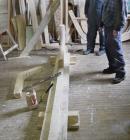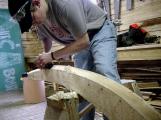14
The spoke shave was an essential tool because it could smooth curved surfaces where the jack plane could not be used.16
A taper is cut on the outside faces of the stem. After being shaped, the stem and sternpost were scarfed (joined) to the keel using deadwood pieces, which were bolted to each joined piece using galvanized bolts.17
Backbone assembly2003
Winterton Boat Building and Community Museum, Newfoundland and Labrador, Canada

18
The keel with one knee trial-fitted (not attached). This is the beginning of the backbone assembly. After scarfing and alignment the backbone assembly was blocked into an upright position on a level floor or on the ground. Wooden blocks were located under the keel at the center and both ends and several boards nailed from the floor, or ground pegs, to the stem and sternpost to ensure these were plumb (balanced and aligned).19
Backbone assembly2003
Winterton Boat Building and Community Museum, Newfoundland and Labrador, Canada

20
A hole is bored through the keel to attach the knee with bolts.21
Backbone assembly2003
Winterton Boat Building and Community Museum, Newfoundland and Labrador, Canada

22
The first knee is bolted onto the keel.23
Backbone assembly2003
Winterton Boat Building and Community Museum, Newfoundland and Labrador, Canada

24
The second and third stern knees are attached. These three knees form the support structure for the counter (back) of the boat.26
C-clamps are essential to secure the pieces during trial-fitting.27
Backbone assembly2003
Winterton Boat Building and Community Museum, Newfoundland and Labrador, Canada


